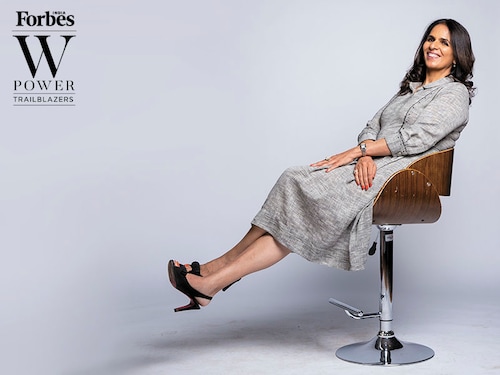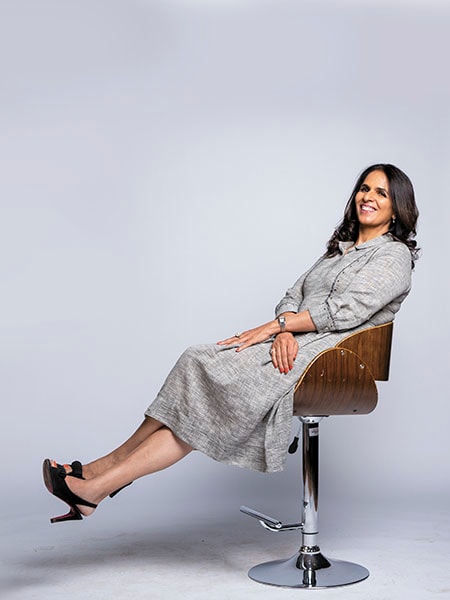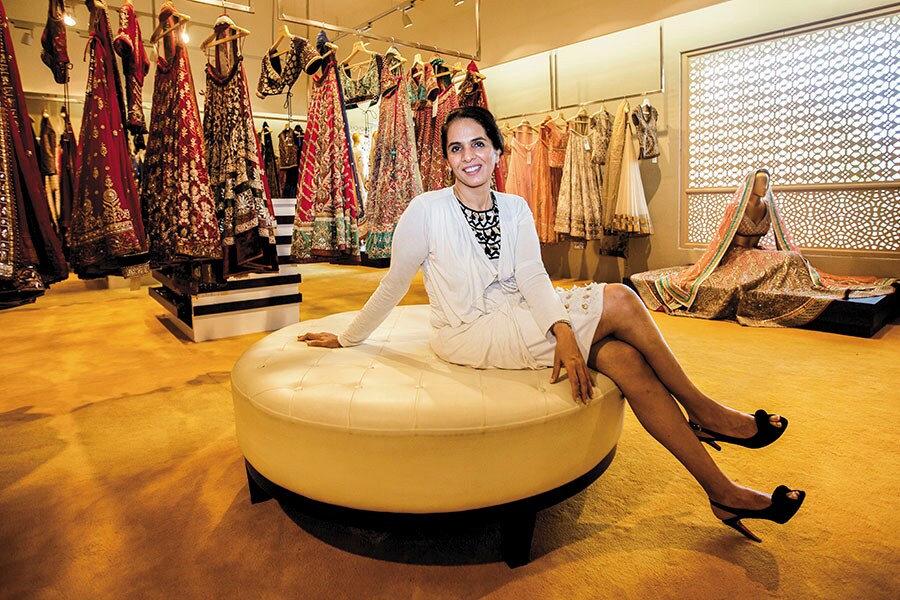Designer Anita Dongre is a runway hit
Around 20 years ago, designer Anita Dongre filled a gap in women's Western wear in India. Today, she's running a veritable fashion empire



Anita Dongre’s fashion business straddles couture and prêt with equal finesse
Image: Mexy XavierIn 1999, when designer Anita Dongre wanted to rent space for a store at Crossroads Mall (since then rechristened Sobo Central) in south Mumbai, her request was initially turned down. The mall owners preferred to rent to big and international brands, and weren’t really confident about a “young, woman entrepreneur”. However, they changed their minds and agreed to give Dongre, then 36 and just starting out, a 300 sq ft space. It was a decision that worked to the advantage of both parties: Dongre says that within one year, her AND store became the best performing store per-square-foot in the mall.
“I am sure some other brand must have pulled out, hence I got that store,” says Dongre, 53, with a laugh as she settles down on a swing at her premium Anita Dongre store in Khar, suburban Mumbai. Dressed in a plain white kurta and cotton pants, and sipping on a cup of hot lemongrass tea, Dongre exudes the confidence of a woman who has achieved what she set out to, despite challenges. Today, the two-storeyed spacious flagship store—opened in May 2015—that we are seated in houses some of her best creations under one roof—from bridal wear in pastel shades, to Western wear in organic fabrics, to handcrafted jadau jewellery.
“Sitting with a mall owner and explaining that I am serious about what I am going to do was a challenge. They didn’t take a woman running a homegrown brand that seriously. People didn’t realise when you are a woman and starting out a business that your vision is to be that big. Today, they realise this. Today, they take me seriously,” says Dongre. “I could sit in a meeting and figure out immediately that someone is not taking me seriously. But it didn’t bother me at all because I knew what I am all about. At times, when I was negotiating for something, the attitude was and I hated that—oh, she runs a small boutique. They always want to view you as somebody very small.”
All that is in the past, though. In about two decades, Dongre has established a veritable empire, her designs available under three distinct brands—AND (Western wear), Global Desi (ethnic wear) and Anita Dongre (bridal, couture prêt, menswear, Pinkcity jewellery and organic clothes Grassroot). Keeping in mind the diverse businesses, AND Designs India Limited, the name by which her company was established in 1995, was rebranded as House of Anita Dongre (HOAD) in 2015, with Dongre as its chief creative officer. The company today employs 2,800 people directly, has 250 exclusive brand outlets, 656 large-format stores, and is available through 83 multi-brand outlets across India. It also expanded to Mauritius, in 2013, with exclusive stores. The net revenues for FY16 stood at Rs 414 crore, a 28 percent growth from the previous year. The earnings before interest, tax, depreciation and amortisation (Ebidta) for FY16 stood at Rs 63 crore, an increase of around 10 percent from 2015. Also, in 2016, Dongre was the most searched designer in India on Google, partly because Kate Middleton, the Duchess of Cambridge, wore a tunic designed by Dongre during her visit to India.
Designing success
Dongre’s strength lies in her ability to learn and adapt, and the fact that she brings together creativity with a keen business sense. “I knew exactly what I wanted and enrolled myself for a degree in fashion designing from Premlila Vithaldas Polytechnic, SNDT University, in Mumbai,” says Dongre, who graduated in 1983. “Also,” she points out, “when you are inclined to any creative field, you are inclined to the process right from the time you are born. So maybe I inherited my mother’s creativity, as she would design and stitch clothes for her daughters.”
“As a student, Anita was very creative in her thinking and is a born leader. I always found her ahead of others in business ideas,” says Usha Batra, former head of the Department of Apparel Manufacture & Design, at Premlila Vithaldas Polytechnic, which felicitated her with a Lifetime Achievement Award for Alumni in 2016.
undefinedHer understanding of the consumer is sharp that translates into beautiful products.[/bq]
After college, Dongre did internships that seem like a precursor to everything HOAD is today—a brand that straddles luxury and prêt with equal finesse. Her first internship was with the esrtwhile royal family of Dhrangadhra, Gujarat, which ran a small high-fashion business from their house at Carmichael Road in Mumbai. They produced expensive, one-of-a-kind outfits for a boutique in the city of Washington, US. “Each outfit was very craft-oriented and took three to six months to produce. It was a labour of love and taught me fineness of work and detailing,” says Dongre, who worked there for over a year and a half.
She then switched to Melco Buying Agencies, owned by Raju Goenka of Texport Syndicate India Ltd, one of India’s largest exporters. It employed over 5,000 people and was in the business of mass producing prêt clothes for American retailers like Target. “Here I learnt about prêt and how lakhs of pieces are produced in a cost-effective way,” recalls Dongre.
Meanwhile, her younger sister Meena Sehra had completed her graduation, and the duo decided to start their own business with two sewing machines in their balcony. They supplied embroidered ethnic clothes to small boutiques on Linking Road, a shopping district in Mumbai, and eventually to larger apparel stores like Sheetal, Big Jo’s and Benzer in Mumbai and Delhi.  Dongre at her store in Phoenix Mills, Mumbai. Unlike many designers, she does not price her ensembles as a single unit
Dongre at her store in Phoenix Mills, Mumbai. Unlike many designers, she does not price her ensembles as a single unit
Image: Kaushik Chakravorty for Forbes IndiaA few years later, Dongre realised that the Indian woman had evolved, and was now looking for Western clothes. Most stores she was supplying to refused to accept this fact, and she decided it was time to fill the gap herself. In 1995 she launched her brand. “Then was born AND, which is truly India’s first Western wear brand of contemporary clothes,” says Dongre with a smile. It was a huge risk, she admits, “but honestly, when you are that young, you just do what you have to do with positivity. I didn’t think of failure.”
Right from the beginning, she had a solid team with her sister Sehra, and brother Mukesh Sawlani, who quit his job abroad as a banker and joined the company by the time Dongre decided to open her first outlet. Sawlani takes care of operations and Sehra is in charge of production and people. “One thing I believe is that if there is anybody who knows more than you, you go to them, because you can’t learn everything yourself. My strength is in the fact that we work as one person,” says Dongre. Her son, Yash (25), is also an integral part of the business today, though her husband Pravin continues to be head of agri business at Glencore (India), an Anglo-Swiss multinational commodity trading and mining company.
“Anita is a classic entrepreneur who has unbridled passion for her work and has aspirations to build the largest lifestyle fashion brand coming out of India. Her understanding of the consumer is sharp and that translates into the beautiful products that you see across her varied brands—in Western wear, fusion and ethnic—at the right price-points,” says Sandeep Naik, head, India and Asean for General Atlantic, which invested in HOAD in 2013, after buying out the stake earlier held by Future Ventures. HOAD is the only fashion house in India that General Atlantic has invested in.
Challenging the status quo
Dongre not only filled a gap at a time when the only options for Western wear available to women were international brands, but also disrupted the fashion scene in the ’90s with her design sensibility, sizes and pricing. “Design for me is not about watching it on the ramp it is about wearability.” For instance, she put pockets in her lehengas, and made them lighter.
Years ago, when it was not so fashionable to showcase wearable clothes on the ramp, her collections were sometimes criticised for being too simple. “But today, world over people are talking about wearability and simplicity on the ramp. I always did that, ahead of my time,” she says.
She was also among the first in India to have sizes from 8 to 18. “I accepted the fact that women come in all shapes and sizes and I don’t know why designers were making only one medium size,” she says.
The third differentiation was that she didn’t price her ensembles as a unit. “We have never taken a whole look and priced it as one. People were aghast when I priced my lehengas, choli and dupatta separately. But I have always said I want women to have their own personality not something I have created,” she explains.
undefinedBy not sticking with one genre of design, Anita has achieved what few other designers have.[/bq]
The inclination to be different, Dongre believes, comes from her college days, when she was a rebel and fashionista. “I am just too basic, boring and simple now. In college, I used to wear dhotis, bandanas and hats. If I entered the room and everybody didn’t look at me, I used to think ‘Oh god, this outfit has gone to waste!’ We were taught to be different.” And that has percolated into her designs over the years. The company now annually designs four collections for Global Desi and AND, and two each for Anita Dongre Bridal, Prêt and Grassroot. Everything and everyone, she says, is a source of inspiration. “Over the years, I have imbibed from so many beautiful women. I have always said that. I have learnt and imbibed from women I meet… who are not famous—clients, artisans, in store, village women in Rajasthan.”
Designer Wendell Rodricks calls Dongre “possibly India’s highest selling designer”. Reason: “She has expanded her label to reach multiple markets of design appreciation, monetary value and bridged everything between wedding and high-end prêt. By not sticking with one genre of design, Anita has achieved what few other designers have.”
Rodricks, who has known Dongre for years, believes her personal simplicity manifests in her work. “As a professional, she works like an island of calm and creativity. As a friend she is rock solid. Above all as a designer, she is beyond the petty world of fashion gossip, intrigue and drama. Put all these parts of a persona together and the real artist Anita Dongre emerges,” he says.
“My approach is that I go to work every day,” Dongre points out. “Fashion is a cycle. I don’t have time to gloat over any success because I am already designing the next collection.” Her advices to aspiring designers is to dig in their heels. “If you are passionate about it, you will find a way to do it. Don’t be bogged down when small hurdles come your way. Every hurdle will teach you something.”
But even her equanimity can crack under the work pressure sometimes. Dongre says she deals with her stress at her Bandra home in Mumbai. “I don’t ever feel the need to leave and travel. I just escape into the confines of my home—have an oil massage, bake a cake, sit with my dog, do nothing, switch off my phone for two days and I come back rejuvenated,” she says.
Those breaks, however, are few and far between. This year began with her show at the grand finale of the Lakme Fashion Week. And that is just the beginning of the year.
First Published: Mar 14, 2017, 07:08
Subscribe Now